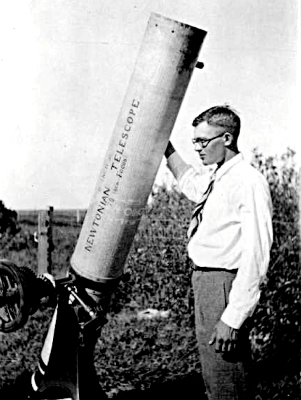Apr 24 2015
The solar system is teeming with tiny rocks – but officially there are only five dwarfs: Ceres, Eris, Haumea, Makemake and Pluto. While the Dawn space probe is currently exploring Ceres, the New Horizons mission will hurtle past big brother Pluto on 14 July and record data and images of this faraway world en passant. The researchers will thus have a chance to more closely investigate two very different, distant dwarf planets.
 The discoverer: Clyde Tombaugh, son of a farmer, was an enthusiastic stargazer. In 1930, while working at the Lowell Observatory in the US state of Arizona, he discovered Pluto, which was considered to be the ninth planet in the solar system until 2006. © in the public domain
The discoverer: Clyde Tombaugh, son of a farmer, was an enthusiastic stargazer. In 1930, while working at the Lowell Observatory in the US state of Arizona, he discovered Pluto, which was considered to be the ninth planet in the solar system until 2006. © in the public domain
In addition to seven scientific instruments, the New Horizons space probe is carrying a special cargo on board: a few grams of the ashes of the astronomer Clyde Tombaugh, who discovered Pluto in 1930 and died in 1997. Tombaugh, son of a farmer, was an enthusiastic stargazer. With his self-made telescope he observed Mars and Jupiter in his youth and sent drawings of these planets to the director of the Lowell Observatory in the US state of Arizona. The latter was so taken with these works that he offered Tombaugh a job.
The new recruit went about his task of tracking down “planet X” with zeal, not least because Percival Lowell, the founder of the observatory, had not only believed in the existence of Martians, but also in an as yet undiscovered celestial body beyond Neptune’s orbit. On the afternoon of 18 February 1930, Clyde Tombaugh compared photographic plates of a region in the Gemini constellation. His attention was caught by a tiny, weak spot of light, which had shifted 3.5 millimetres within three days: “planet X”.
On 14 March 1930, the newspapers reported his sensational find. On the very same day, a librarian from Oxford wrote to the English astronomer Herbert Hall Turner that his eleven-year-old granddaughter had heard of the discovery and spontaneously proposed Pluto as its name. Turner did in fact pass on this idea to the Lowell Observatory – and the astronomers there agreed immediately.
The name fits in well with the mythological names of the other planets: Pluto is the Roman god of the underworld, who the Greeks called Hades or Aidoneos. Moreover, the first two letters are also the initials of the observatory founder, Percival Lowell. The woman who originally thought up the name was Venetia Phair, née Burney. She lived to see the demotion of her “godchild” to a dwarf planet in 2006 – and passed away in April 2009 aged 90.
Owing to its great distance – it is 5.9 billion kilometres from the Sun on average, 40 times further than Earth – Pluto is an uncharted region on the astronomical map. Even in opposition, when it is closest to Earth, the distance from Earth to the dwarf planet is still around 4.7 billion kilometres. The reflected sunlight from Pluto needs no less than a full four hours to reach us.
Pluto requires just about 248 terrestrial years to orbit the Sun once. Its orbit has a large inclination to the plane of the planetary system. In addition, gravity has adjusted the orbital period of Pluto and its neighbour Neptune to a ratio of two to three. These characteristics are also shared by the Plutinos – small bodies at the edge of the solar system that were discovered at the beginning of the 1990s.
Text: Helmut Hornung